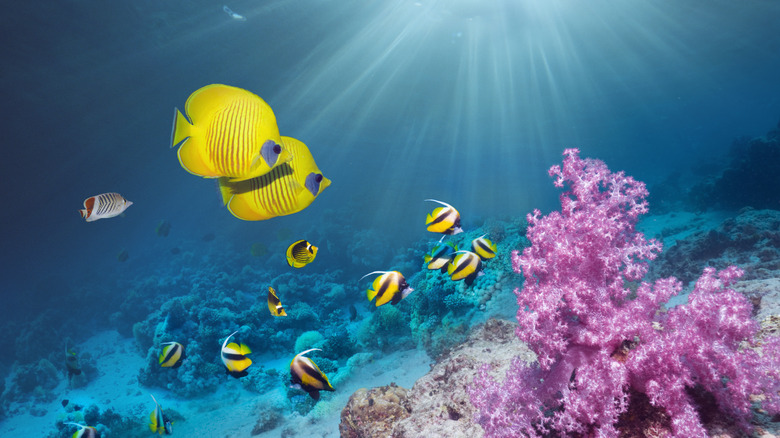5 Characteristics That All Fish Have In Common
Fish are diverse — each species has evolved to live successfully in its specific underwater environment, from streams and lakes to the vast expanse of the ocean. In fact, fish are the most diverse animal species among the vertebrates with 32,000 different types of fish according to FishBase, a comprehensive database of information on fish used by researchers and zoologists.
Despite the thousands of different species with various adaptations, all fish share some common evolutionary adaptations that help them thrive in their watery domain. While there are some rare exceptions to these rules, below is a list of the traits common across these aquatic animals.
1. Most fish are cold-blooded
Almost all fish are cold-blooded, which is also called ectothermic. This means that fish are unable to regulate their body temperature, relying solely on the outside environment for temperature regulation. The body temperature of fish changes as the environment's temperature changes. This is the opposite of mammals, which rely on internal processes to maintain a constant body temperature.
Many fish species are extremely sensitive to these temperature changes and are only able to exist in a specific water temperature. Other species are able to survive in wider temperature ranges.
A fish's body temperature fluctuates according to the water's temperature around them. As a result, colder waters decrease a fish's body temperature, which can make them sluggish or go dormant during cold spells (like during the winter months in a lake, for example).
2. Water habitat
Another shared characteristic amongst all fish is that they live in water. This may seem too obvious to be worth stating, but there are some fish that can spend significant amounts of time out of the water. Mudskippers, for instance eat and interact with each other on land, and often go underwater only to hide from predators. They do not have lungs but can breathe through their skin and keep their gills moist with water that they store internally.
Something to note here though is that while all fish live in water, not everything that lives in water is a fish. Whales and dolphins, for example, are mammals. Turtles live in water, too, but they're reptiles, not fish.
3. Gills to breathe
One of the basic criteria for an animal to be classified as a fish is the presence of gills throughout its life cycle. Gills are a necessity for underwater life: gills allow fish to absorb oxygen from water and release carbon dioxide, which allows them to "breathe" underwater.
All fish have gills, but some species of fish living in extremely oxygen-depleted environments have developed lungs as well.
As with living in water, all fish have gills but not everything that has gills is a fish. Fish have gills throughout their lifespan while other species that have gills often lose them at some point. Tadpoles, for example, have gills, but eventually lose them as they metamorphose into frogs.
4. Swim bladders
All fish have a swim bladder, which is a specialized organ filled with air that helps ensure fish maintains a stable buoyancy in the water, neither sinking or floating too much.
The presence of a swim bladder allows the fish to sleep without sinking to the bottom of its habitat. In some species of fish, air is swallowed and sent to the swim bladder. This adaptation also helps the fish to survive in waters that do not have adequate levels of oxygen.
5. Fins for movement
Fins are an almost universal characteristic of fish. Many types of fins exist, but the most common are the tail fin, a matching pair of side fins, dorsal fins, and an anal fin.
The general purpose of fins is to provide motion, maneuverability, and stability. Pelvic and pectoral fins allow the fish to maneuver and maintain its stability while dorsal and ventral fins reduce the rolling motion while the fish is swimming and aids the fish during turns. The tail fin propels the fish forward while swimming.
That being said, there are no set shapes, sizes, or even specific purposes for a particular kind of fin. Fin use and purpose varies wildly depending on the adaptations and needs of each type of fish.
